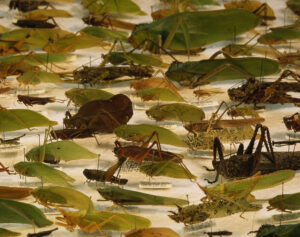 MOON Desk: Biodiversity refers to the variety of living species on Earth, including plants, animals, bacteria, and fungi. While Earth’s biodiversity is so rich that many species have yet to be discovered, many species are being threatened with extinction due to human activities, putting the Earth’s magnificent biodiversity at risk.
MOON Desk: Biodiversity refers to the variety of living species on Earth, including plants, animals, bacteria, and fungi. While Earth’s biodiversity is so rich that many species have yet to be discovered, many species are being threatened with extinction due to human activities, putting the Earth’s magnificent biodiversity at risk.
Although all of these insects have a similar structure and may be genetic cousins, the beautiful variety of colors, shapes, camouflage, and sizes showcase the level of diversity possible even within a closely-related group of species.
Although all of these insects have a similar structure and may be genetic cousins, the beautiful variety of colors, shapes, camouflage, and sizes showcase the level of diversity possible even within a closely-related group of species.
Biodiversity is a term used to describe the enormous variety of life on Earth. It can be used more specifically to refer to all of the species in one region or ecosystem. Biodiversity refers to every living thing, including plants, bacteria, animals, and humans. Scientists have estimated that there are around 8.7 million species of plants and animals in existence. However, only around 1.2 million species have been identified and described so far, most of which are insects. This means that millions of other organisms remain a complete mystery.
Over generations, all of the species that are currently alive today have evolved unique traits that make them distinct from other species. These differences are what scientists use to tell one species from another. Organisms that have evolved to be so different from one another that they can no longer reproduce with each other are considered different species. All organisms that can reproduce with each other fall into one species.
Scientists are interested in how much biodiversity there is on a global scale, given that there is still so much biodiversity to discover. They also study how many species exist in single ecosystems, such as a forest, grassland, tundra, or lake. A single grassland can contain a wide range of species, from beetles to snakes to antelopes. Ecosystems that host the most biodiversity tend to have ideal environmental conditions for plant growth, like the warm and wet climate of tropical regions. Ecosystems can also contain species too small to see with the naked eye. Looking at samples of soil or water through a microscope reveals a whole world of bacteria and other tiny organisms.
Some areas in the world, such as areas of Mexico, South Africa, Brazil, the southwestern United States, and Madagascar, have more biodiversity than others. Areas with extremely high levels of biodiversity are called hotspots. Endemic species—species that are only found in one particular location—are also found in hotspots.
All of the Earth’s species work together to survive and maintain their ecosystems. For example, the grass in pastures feeds cattle. Cattle then produce manure that returns nutrients to the soil, which helps to grow more grass. This manure can also be used to fertilize cropland. Many species provide important benefits to humans, including food, clothing, and medicine.
Much of the Earth’s biodiversity, however, is in jeopardy due to human consumption and other activities that disturb and even destroy ecosystems. Pollution, climate change, and population growth are all threats to biodiversity. These threats have caused an unprecedented rise in the rate of species extinction. Some scientists estimate that half of all species on Earth will be wiped out within the next century. Conservation efforts are necessary to preserve biodiversity and protect endangered species and their habitats.







